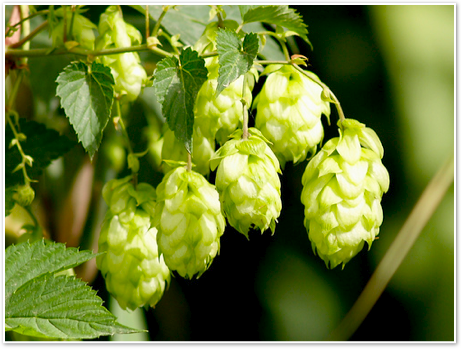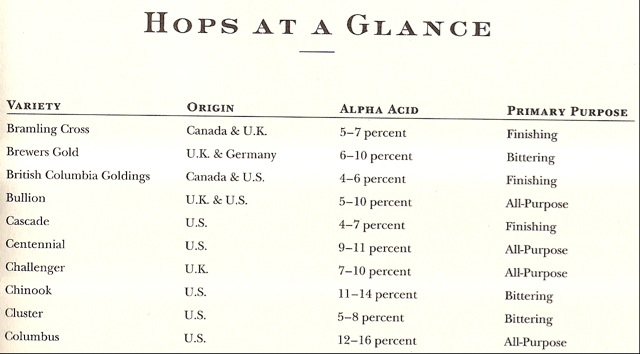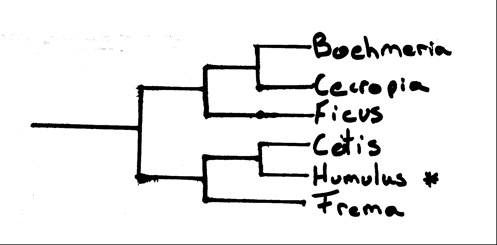Three different species of the genus Humulus are recognized. Each differ slightly to each other by the range of habitat it can live in, growth rate, and amount of chemicals in the strobiles:
Humulus lupulus-
Humulus: This Latin name is unknown in origin. Some believe it is derived from a German word humela. Others say is comes from humus, a common component in the soil the plant can grow in.
lupulus: This word translates from Latin into “small wolf”. This is derived from the growth habit of the plant; always trying to climb up and over other plants and objects, like wolf do to sheep.
The English name Hop comes from the Anglo-Saxon word hoppan, meaning “to climb”, again referring to the nature of its growth.
This is the common hop, the hop most people are familiar with. Most, if not all commercial hops are H. lupulus var. lupulus. Why is this so? Different varieties of this species are grown to emphasis different characteristics they have, usually involving the chemistry of the cones. Similar to grapes for wine, the area the H. lupulus is grown in aides in the profile of the hop. (i.e alpha acid content, oil content, and the purpose of the hop. (Fig 1)




Humulus japonicus-
This species is native to China, Japan, Taiwan, and has been introduced to North America as well. This species is very adaptable to many places on Earth because of its durability as a plant and seed, its aggressive growth, and genotype that is said to be “general purpose”.
Humulus yunnanensis-
Not much is known about this species. Dr. Ernest Small, a scientist from a section of the AAFC (Agriculture & Agri-Food Canada), did much research on the Humulus genera (as well as the Cannabis genera) and made much progress studying H. yunnanensis. It is believed to have been over-looked for quite awhile because it shares many features similar to H. japonicus, although it is mistaken commonly for H. lupulus in herbarium samples. Dr. Small studied roughly 783 specimens of Humulus, and finally found this hidden species.
Domain: Eukaryote
=> Contains membrane bound organelles (cell structures), main one being the nucleus.
Kingdom: Plantae
=> This organism is multicellular, photosynthetic, and contains cellulose
Subkingdom: Tracheobionta
=> Vascular plants, having a system to transport water and other nutrients. Allows for greater height to be achieved.
Division: Magnoliophyta
=> Flowering plants, producing structures called flowers to create, pollenate, and hold seeds for reproduction (the fruit of the plant). This is the cone, or hop of the H. lupulus plant
Class: Magnoliopsida
=> Dicotyledons, flowering plants that have two embryonic leaves when it comes out off soil.
Order: Urticales
=> Flowering plants with variations of circumscription
Family: Cannabaceae
=> Hemp family, bet you didn’t realize that! Organisms here have more or less lobed leaves, are dioecious (male and female plants), and pollen is wind spread. Little to no primary growth is seen here as well.
Genus: Humulus
=> Have characteristic cones, chemical composition, style and growth pattern
Species: Humulus lupulus
=> Common hop, brewing hop
Classification
This species has been further sub-divided into five subspecies:
H. lupulus var. lupulus
H. lupulus var. cordifolius
H. lupulus var. neomexicanus
H. lupulus var. pubescens
H. lupulus var. lupuloides
Each is separated into separate sub-categories by morphological and geographic features. For example, leaf characteristics, number of glands, leaf lobes and hairs are parts used to differentiate these five.
I do encourage you to further look into the differences! For the purposes of this website, Humulus lupulus will be looked at as the main inquiry, focusing more on the general characteristics of the species, and not the sub divisions.




Although crude, the above phylogenetic tree is based on morphology, primarily branch length. The Humulus genera is seen in close relation with the Ceitis genera, or huckberry berry plant. A bit farther away, the Ficus genera, category with Fig trees in it, has a similar morphology and branch length. Dioecious, shrubby, flowering plants are some characteristics that are present and similar in these genera.